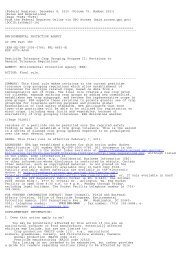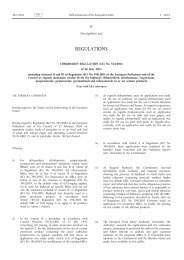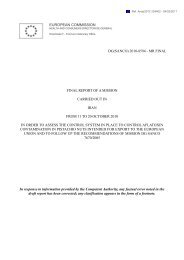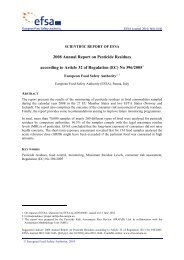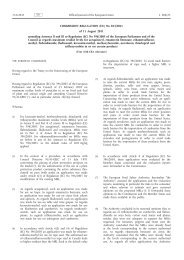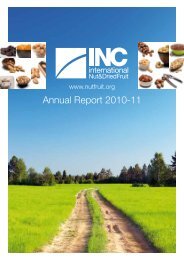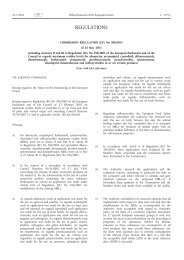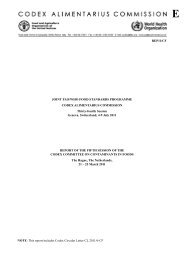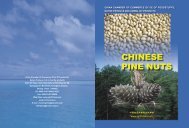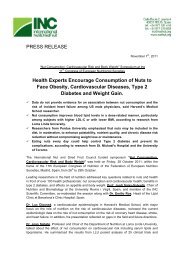final report of a mission carried out in brazil from 15 to 24 march ...
final report of a mission carried out in brazil from 15 to 24 march ...
final report of a mission carried out in brazil from 15 to 24 march ...
Create successful ePaper yourself
Turn your PDF publications into a flip-book with our unique Google optimized e-Paper software.
EUROPEAN COMMISSIONHEALTH AND CONSUMERS DIRECTORATE-GENERALDirec<strong>to</strong>rate F - Food and Veter<strong>in</strong>ary OfficeAres(2010)540847DG(SANCO) 2010-8570 - MR FINALFINAL REPORT OF A MISSIONCARRIED OUT INBRAZILFROM <strong>15</strong> TO <strong>24</strong> MARCH 2010IN ORDER TO ASSESS THE CONTROL SYSTEM IN PLACE TO CONTROL AFLATOXINCONTAMINATION IN BRAZIL NUTS INTENDED FOR EXPORT TO THE EUROPEANUNIONIn response <strong>to</strong> <strong>in</strong>formation provided by the Competent Authority, any factual error noted <strong>in</strong> thedraft <strong>report</strong> has been corrected; any clarification appears <strong>in</strong> the form <strong>of</strong> a footnote.
ABBREVIATIONS AND DEFINITIONS USED IN THIS REPORTAbbreviationANVISAAOACASBRAERCACCACCRCCGALCNDIPOVDNSFEMBRAPAEUFBOFVOGAPGMPGSPHACCPHPLCIBGEINMETROISOLACQSA/LANAGRO-MGLOQExplanationNational Health Surveillance AgencyAssociation <strong>of</strong> Analytical CommunitiesBrazilian Association <strong>of</strong> State Technical Assistance and Rural ExtensionEntitiesCompetent AuthorityCentral Competent AuthorityCoord<strong>in</strong>ation for Control <strong>of</strong> Residues and Contam<strong>in</strong>antsGeneral Coord<strong>in</strong>ation for Labora<strong>to</strong>ry SupportComb<strong>in</strong>ed NomenclatureDepartment <strong>of</strong> Plant Product InspectionDepartment <strong>of</strong> Sanitary and International RelationsBrazilian Agricultural Research CorporationEuropean UnionFood Bus<strong>in</strong>ess Opera<strong>to</strong>rFood and Veter<strong>in</strong>ary OfficeGood Agricultural PracticeGood Manufactur<strong>in</strong>g PracticeGood S<strong>to</strong>rage PracticeHazard Analysis and Critical Control Po<strong>in</strong>tHigh Performance Liquid Chroma<strong>to</strong>graphyBrazilian Institute <strong>of</strong> Geography and StatisticsBrazilian National Accreditation BodyInternational Organisation for StandardisationQuality Control and Food Safety Labora<strong>to</strong>ry <strong>of</strong> the National Agriculturaland Lives<strong>to</strong>ck Labora<strong>to</strong>ryLimit <strong>of</strong> QuantificationIII
MAPAMSRASFFSDASFASIPAGSOPSTDFTLCVIGIAGROM<strong>in</strong>istry <strong>of</strong> Agriculture, Lives<strong>to</strong>ck and Food SupplyMember StatesRapid Alert System for Food and FeedSecretariat for Animal and Plant HealthRegional Office <strong>of</strong> MAPAPlant and Animal Products Inspection ServiceStandard Operat<strong>in</strong>g ProcedureStandards and Trade Development FacilityTh<strong>in</strong>-Layer Chroma<strong>to</strong>graphyCoord<strong>in</strong>ation for International Agricultural and Lives<strong>to</strong>ck SurveillanceIV
1INTRODUCTIONThe <strong>mission</strong> <strong>to</strong>ok place <strong>in</strong> Brazil <strong>from</strong> <strong>15</strong> <strong>to</strong> <strong>24</strong> March 2010. The <strong>mission</strong> team comprised two<strong>in</strong>spec<strong>to</strong>rs <strong>from</strong> the Food and Veter<strong>in</strong>ary Office (FVO) and one Member State expert.The <strong>mission</strong> team was accompanied dur<strong>in</strong>g the <strong>mission</strong> by representatives <strong>from</strong> the CentralCompetent Authority (CCA), the M<strong>in</strong>istry <strong>of</strong> Agriculture, Lives<strong>to</strong>ck and Food Supply (MAPA).An open<strong>in</strong>g meet<strong>in</strong>g was held on <strong>15</strong> March at the premises <strong>of</strong> MAPA <strong>in</strong> Brasilia. Representatives<strong>from</strong> the different units <strong>of</strong> MAPA (Secretariat for Animal and Plant Health — SDA, Coord<strong>in</strong>ationfor Control <strong>of</strong> Residues and Contam<strong>in</strong>ants — CCRC, Department <strong>of</strong> Plant Product Inspection —DIPOV, General Coord<strong>in</strong>ation for Labora<strong>to</strong>ry Support — CGAL, Coord<strong>in</strong>ation for InternationalAgricultural and Lives<strong>to</strong>ck Surveillance — VIGIAGRO) were present. At this meet<strong>in</strong>g, theobjectives <strong>of</strong> <strong>of</strong> the <strong>mission</strong> were confirmed and it<strong>in</strong>erary for the <strong>mission</strong> <strong>f<strong>in</strong>al</strong>ised by the <strong>mission</strong>team.2 OBJECTIVES OF THE MISSIONThe objectives <strong>of</strong> the <strong>mission</strong> were <strong>to</strong>:• verify whether the control systems are <strong>in</strong> place <strong>to</strong> control afla<strong>to</strong>x<strong>in</strong> contam<strong>in</strong>ation <strong>in</strong> Brazilnuts <strong>in</strong>tended for export <strong>to</strong> the European Union (EU) with<strong>in</strong> specified European Unioncontam<strong>in</strong>ant limits, comply<strong>in</strong>g with or be<strong>in</strong>g at least equivalent <strong>to</strong> Com<strong>mission</strong> Regulation(EC) No 1881/2006.• assess compliance with conditions <strong>in</strong> Com<strong>mission</strong> Regulation (EC) No 1<strong>15</strong>2/2009 on specialconditions govern<strong>in</strong>g certa<strong>in</strong> foodstuffs imported <strong>from</strong> certa<strong>in</strong> third countries due <strong>to</strong>contam<strong>in</strong>ation risks <strong>of</strong> these products by afla<strong>to</strong>x<strong>in</strong>s.• follow up on recommendations made <strong>in</strong> <strong>report</strong> SANCO 7074/2004.In pursuit <strong>of</strong> these objectives, the follow<strong>in</strong>g visits were <strong>carried</strong> <strong>out</strong> <strong>in</strong> accordance with the it<strong>in</strong>eraryagreed between MAPA and the FVO:COMPETENT AUTHORITY VISITSCOMMENTSCompetent authority Central 1 MAPALABORATORY VISITSRegional 1 Regional Office <strong>of</strong> MAPA (SFA) <strong>in</strong> Pará StateOfficial labora<strong>to</strong>ries 2 Private labora<strong>to</strong>ry authorised for <strong>of</strong>ficial analysis (<strong>in</strong>San<strong>to</strong>s)Private labora<strong>to</strong>ry authorised for <strong>of</strong>ficial analysis (<strong>in</strong>São Paulo)FOOD PROCESSING ESTABLISHMENTSHarvest<strong>in</strong>g areas 1 1 community around ÓbidosBrazil nut processors/exporters 2 1 processor/exporter <strong>in</strong> Belém1 processor/exporter <strong>in</strong> ÓbidosPORTS OF EXPORT1 Port <strong>of</strong> Belém, Pará State1
3LEGAL BASIS FOR THE MISSION3.1 LEGAL BASISThe <strong>mission</strong> was <strong>carried</strong> <strong>out</strong> <strong>in</strong> agreement with MAPA under the general provisions <strong>of</strong> EUlegislation, <strong>in</strong> particular:• Article 46 <strong>of</strong> Regulation (EC) No 882/2004 <strong>of</strong> the European Parliament and <strong>of</strong> the Council.Full references <strong>to</strong> the acts quoted <strong>in</strong> this <strong>report</strong> are given <strong>in</strong> the Annex. Legal acts quoted <strong>in</strong> this<strong>report</strong> refer, where applicable, <strong>to</strong> the last amended version.4 BACKGROUND4.1 OVERVIEW OF PREVIOUS MISSIONS REGARDING AFLATOXIN CONTAMINATION IN FOODSTUFFSThe European Com<strong>mission</strong> has <strong>carried</strong> <strong>out</strong> <strong>mission</strong>s <strong>to</strong> Iran, Egypt, Turkey, Ch<strong>in</strong>a, Brazil, India,Argent<strong>in</strong>a, USA, Ghana, Peru and Azerbaijan <strong>to</strong> evaluate <strong>of</strong>ficial control systems for prevent<strong>in</strong>gafla<strong>to</strong>x<strong>in</strong> contam<strong>in</strong>ation <strong>in</strong> foodstuffs orig<strong>in</strong>at<strong>in</strong>g <strong>from</strong> these countries. In addition, there have been<strong>mission</strong>s <strong>to</strong> 18 Member States (MS) <strong>to</strong> assess controls on imported products <strong>of</strong> plant orig<strong>in</strong>. The<strong>report</strong>s on these <strong>mission</strong>s are available on DG Health and Consumers’ <strong>in</strong>ternet site athttp://ec.europa.eu/food/fvo/ir_search_en.cfm.4.2 BACKGROUND TO PRESENT MISSIONThe competent authorities (CA) <strong>of</strong> the EU MS are obliged <strong>to</strong> carry <strong>out</strong> r<strong>out</strong><strong>in</strong>e sampl<strong>in</strong>g andanalysis <strong>of</strong> various agricultural products orig<strong>in</strong>at<strong>in</strong>g <strong>from</strong> third countries. These <strong>in</strong>clude nuts and nutproducts.As <strong>out</strong>l<strong>in</strong>ed <strong>in</strong> <strong>report</strong>s SANCO 9027/2003 and SANCO/7074/2004, an <strong>in</strong>creased number <strong>of</strong> Brazilnut consignments rejected due <strong>to</strong> afla<strong>to</strong>x<strong>in</strong> contam<strong>in</strong>ation were notified <strong>to</strong> the Com<strong>mission</strong>’s RapidAlert System for Food and Feed (RASFF) <strong>in</strong> 2001 and 2002. The FVO, <strong>in</strong> consultation withrelevant Com<strong>mission</strong> services, decided <strong>to</strong> conduct a <strong>mission</strong> with the agreement <strong>of</strong> the Brazilianauthorities <strong>to</strong> address this rise <strong>in</strong> non-compliance <strong>in</strong> 2003. Follow-up <strong>mission</strong> was conducted <strong>in</strong>2004. Both <strong>mission</strong>s resulted <strong>in</strong> several recommendations made <strong>to</strong> the Brazilian authorities.In order <strong>to</strong> address the shortcom<strong>in</strong>gs found, specific conditions for the import <strong>of</strong> Brazil nuts havebeen laid down by EU legislation, most recently Com<strong>mission</strong> Regulation (EC) No 1<strong>15</strong>2/2009.Under this Regulation, Brazil nuts exported <strong>to</strong> the EU have <strong>to</strong> be accompanied by a healthcertificate issued by MAPA <strong>to</strong> show that the consignment was sampled and analysed <strong>in</strong> accordancewith Com<strong>mission</strong> Regulation (EC) No 401/2006. MS are obliged <strong>to</strong> perform documentary checksand further sampl<strong>in</strong>g and analysis for afla<strong>to</strong>x<strong>in</strong> B1 and <strong>to</strong>tal afla<strong>to</strong>x<strong>in</strong> on each consignment at thepo<strong>in</strong>t <strong>of</strong> entry. Any non-compliance found results <strong>in</strong> the consignment be<strong>in</strong>g refused entry <strong>in</strong><strong>to</strong> theEU and its subsequent return <strong>to</strong> the place <strong>of</strong> orig<strong>in</strong> or destruction.The ma<strong>in</strong> MS <strong>of</strong> entry (based on figures for 2008-2009 provided by EUROSTAT) are theNetherlands, Germany, Italy and the UK. The majority <strong>of</strong> nuts are imported between June andSeptember. Accord<strong>in</strong>g <strong>to</strong> EUROSTAT data, there has been a significant decl<strong>in</strong>e <strong>in</strong> Brazil nutimports <strong>from</strong> Brazil <strong>to</strong> the EU s<strong>in</strong>ce the last <strong>mission</strong>.Table 1: Imports <strong>in</strong><strong>to</strong> the European Union <strong>in</strong> <strong>to</strong>nnes/year:2002 2003 2004 2005 2006 2007 2008 2009Brazil 3314 1859 135 - 126 133 <strong>15</strong>9 1612
nuts <strong>in</strong>shellShelledBrazilnuts1419 553 1096 1170 252 688 353 317.7Source: Eurostat database4.3 FOOD PRODUCT INFORMATION CONCERNING PUBLIC HEALTH ISSUESAfla<strong>to</strong>x<strong>in</strong>s are myco<strong>to</strong>x<strong>in</strong>s produced by certa<strong>in</strong> species <strong>of</strong> Aspergillus, which develop at hightemperatures and humidity levels and may be present <strong>in</strong> a large number <strong>of</strong> foods. The afla<strong>to</strong>x<strong>in</strong>group <strong>in</strong>cludes a number <strong>of</strong> compounds <strong>of</strong> vary<strong>in</strong>g <strong>to</strong>xicity and frequency <strong>in</strong> food. Afla<strong>to</strong>x<strong>in</strong> B1 isthe most <strong>to</strong>xic compound. For safety reasons, it is advisable <strong>to</strong> limit both the <strong>to</strong>tal afla<strong>to</strong>x<strong>in</strong> content(compounds B1, B2, G1 and G2) <strong>in</strong> food and the afla<strong>to</strong>x<strong>in</strong> B1 content. Maximum limits forafla<strong>to</strong>x<strong>in</strong>s <strong>in</strong> food have been fixed <strong>in</strong> legislation tak<strong>in</strong>g <strong>in</strong><strong>to</strong> account the known possible effects <strong>of</strong>sort<strong>in</strong>g, mix<strong>in</strong>g or other physical treatment methods <strong>to</strong> reduce afla<strong>to</strong>x<strong>in</strong> content. In accordance withAnnex I <strong>to</strong> Regulation (EC) No 1881/2006, the maximum admissible afla<strong>to</strong>x<strong>in</strong> levels <strong>in</strong> groundnuts,nuts and dried fruit are as follows:• Hazelnuts and Brazil nuts <strong>in</strong>tended for direct human consumption or use as an <strong>in</strong>gredient <strong>in</strong>foodstuffs:5.0 μg/kg afla<strong>to</strong>x<strong>in</strong> B1 content, and10.0 μg/kg <strong>to</strong>tal afla<strong>to</strong>x<strong>in</strong> content (sum <strong>of</strong> B1, B2, G1 and G2).• Hazelnuts and Brazil nuts subject <strong>to</strong> sort<strong>in</strong>g or other physical treatment before humanconsumption or use as an <strong>in</strong>gredient <strong>in</strong> foodstuffs:8.0 μg/kg afla<strong>to</strong>x<strong>in</strong> B1 content, and<strong>15</strong>.0 μg/kg <strong>to</strong>tal afla<strong>to</strong>x<strong>in</strong> content (sum <strong>of</strong> B1, B2, G1 and G2).Sampl<strong>in</strong>g also plays a crucial part <strong>in</strong> determ<strong>in</strong><strong>in</strong>g myco<strong>to</strong>x<strong>in</strong> levels, which may be veryheterogeneously distributed <strong>in</strong> a consignment. Com<strong>mission</strong> Regulation (EC) No 401/2006 thereforeestablishes sampl<strong>in</strong>g procedures and general criteria <strong>to</strong> ensure that labora<strong>to</strong>ries carry<strong>in</strong>g <strong>out</strong>analyses use methods <strong>of</strong> analysis with comparable levels <strong>of</strong> performance.5 FINDINGS AND CONCLUSIONS5.1 LEGAL REQUIREMENTSArticle 11 <strong>of</strong> Regulation (EC) No 178/2002 requires food and feed imported <strong>in</strong><strong>to</strong> the EU for plac<strong>in</strong>gon the EU market <strong>to</strong> comply with the relevant requirements <strong>of</strong> EU food law or conditionsrecognised by the EU <strong>to</strong> be at least equivalent.Article 10 <strong>of</strong> Regulation (EC) No 852/2004, <strong>in</strong> conjunction with its Article 3, requires food bus<strong>in</strong>essopera<strong>to</strong>rs (FBOs) <strong>to</strong> ensure that all stages <strong>in</strong> the production, process<strong>in</strong>g and distribution <strong>of</strong> foodunder their control comply with the relevant hygiene requirements laid down <strong>in</strong> this Regulation.Article 10 <strong>of</strong> Regulation (EC) No 852/2004, <strong>in</strong> conjunction with its Article 4(1), requires that FBOscarry<strong>in</strong>g <strong>out</strong> primary production and associated operations listed <strong>in</strong> Annex I comply with the generalhygiene provisions laid down <strong>in</strong> part A <strong>of</strong> Annex I.Article 10 <strong>of</strong> Regulation (EC) No 852/2004, <strong>in</strong> conjunction with its Article 4(2), requires that FBOsengaged <strong>in</strong> any stage <strong>in</strong> the production, process<strong>in</strong>g and distribution <strong>of</strong> food after those stages <strong>to</strong>3
which Article 4(1) applies comply with the general hygiene requirements laid down <strong>in</strong> Annex II.Article 10 <strong>of</strong> Regulation (EC) No 852/2004, <strong>in</strong> connection with its Article 5, requires FBOs <strong>to</strong> put<strong>in</strong> place, implement and ma<strong>in</strong>ta<strong>in</strong> a permanent procedure or procedures based on HACCPpr<strong>in</strong>ciples.Article 1 <strong>of</strong> Regulation (EC) No 401/2006 requires that sampl<strong>in</strong>g for the <strong>of</strong>ficial control <strong>of</strong>myco<strong>to</strong>x<strong>in</strong> levels <strong>in</strong> foodstuffs be <strong>carried</strong> <strong>out</strong> <strong>in</strong> accordance with the methods set <strong>out</strong> <strong>in</strong> its Annex I.Concern<strong>in</strong>g nuts (Brazil nuts), the method <strong>of</strong> sampl<strong>in</strong>g is laid down <strong>in</strong> Annex I.D.Article 2 <strong>of</strong> Regulation (EC) No 401/2006 requires that sample preparation and methods <strong>of</strong> analysisused for the <strong>of</strong>ficial control <strong>of</strong> myco<strong>to</strong>x<strong>in</strong> levels <strong>in</strong> foodstuffs comply with the criteria set <strong>out</strong> <strong>in</strong> itsAnnex II.Article 3 <strong>of</strong> Regulation (EC) No 1<strong>15</strong>2/2009 requires that consignments <strong>of</strong> foodstuffs as referred <strong>to</strong><strong>in</strong> Article 1 <strong>of</strong> the Regulation may only be imported <strong>in</strong><strong>to</strong> the EU <strong>in</strong> accordance with the procedureslaid down <strong>in</strong> this Regulation. Article 1(a) <strong>of</strong> the Regulation states that it applies <strong>to</strong> imports <strong>of</strong> thefollow<strong>in</strong>g Brazil nuts orig<strong>in</strong>at<strong>in</strong>g or consigned <strong>from</strong> Brazil: Brazil nuts <strong>in</strong> shell com<strong>in</strong>g undercategory CN code 0801 21 00 and mixtures <strong>of</strong> nuts and dried fruits com<strong>in</strong>g under CN code 0813 50and conta<strong>in</strong><strong>in</strong>g Brazil nuts <strong>in</strong> shell.Article 4 <strong>of</strong> Regulation (EC) No 1<strong>15</strong>2/2009 requires that Brazil nuts presented for import <strong>in</strong><strong>to</strong> theEU must be accompanied by the results <strong>of</strong> sampl<strong>in</strong>g and analysis and a health certificate <strong>in</strong>accordance with the model set <strong>out</strong> <strong>in</strong> Annex I for foodstuffs <strong>from</strong> Brazil, completed, signed andverified by an authorised representative <strong>of</strong> the MAPA.5.2 RELEVANT NATIONAL LEGISLATIONF<strong>in</strong>d<strong>in</strong>gsMa<strong>in</strong> legislation relevant <strong>to</strong> this <strong>mission</strong>:• Decree No 6268/2007, implement<strong>in</strong>g Law 9972/2000, establishes among other th<strong>in</strong>gs thatestablishments <strong>in</strong>volved <strong>in</strong> the classification <strong>of</strong> plant products (such as Brazil nuts) have <strong>to</strong>be registered <strong>in</strong> the General Classification Registry. This also <strong>in</strong>cludes establishmentsproduc<strong>in</strong>g nuts for the domestic market.• MAPA Normative Instruction No 66/2003, <strong>in</strong> connection with paragraph 2 <strong>of</strong> Article 2 <strong>of</strong>Normative Instruction No 13/2004, establishes manda<strong>to</strong>ry requirements for the registration<strong>of</strong> exporters <strong>of</strong> Brazil nuts <strong>to</strong> the EU. It also establishes a general requirement for export<strong>in</strong>gestablishments <strong>to</strong> implement Good Manufactur<strong>in</strong>g Practices (GMP), but does not specifywhat requirements these establishments have <strong>to</strong> meet. Accord<strong>in</strong>g <strong>to</strong> the CAs, MAPAAdm<strong>in</strong>istrative Order No 377/2009, which is currently <strong>in</strong> the public consultation stage, willreplace Normative Instruction No 66/2003.• MAPA Normative Instruction No 12/2004 states that the export <strong>of</strong> <strong>in</strong>-shell Brazil nuts issubject <strong>to</strong> specific health certification by MAPA when required by import<strong>in</strong>g countries.• MAPA Normative Instruction No 13/2004 establishes detailed procedures for thecertification <strong>of</strong> Brazil nuts exported <strong>to</strong> the EU, sampl<strong>in</strong>g and procedures for the control <strong>of</strong>consignments rejected at the po<strong>in</strong>t <strong>of</strong> import.• MAPA Normative Instruction No 42/2008 establishes general requirements for theimplementation <strong>of</strong> the National Residues and Contam<strong>in</strong>ants Control Plan for Plant Products.MAPA Normative Instruction No 21/2009 approves this National Residues andContam<strong>in</strong>ants Control Plan for the 2009/2010 harvest<strong>in</strong>g season.• A limit <strong>of</strong> 30 ppb for <strong>to</strong>tal afla<strong>to</strong>x<strong>in</strong> content <strong>in</strong> Brazil nuts is set for the Brazilian domestic4
market by Resolution CNNPA/MS No 34/76.• M<strong>in</strong>isterial Normative Instruction No 1 <strong>of</strong> 16 January 2007 establishes the guidel<strong>in</strong>es,requirements and rules for the authorisation <strong>of</strong> <strong>of</strong>ficial labora<strong>to</strong>ries. These requirements<strong>in</strong>clude compliance with the criteria <strong>of</strong> ISO 17025, participation <strong>in</strong> pr<strong>of</strong>iciency testsprovided or designated by MAPA, manda<strong>to</strong>ry use <strong>of</strong> the MAPA Official Certificate <strong>of</strong>Analysis template, and use <strong>of</strong> MAPA-approved methods or validation guidel<strong>in</strong>es. There isalso a legal requirement for accreditation <strong>of</strong> these labora<strong>to</strong>ries by the Brazilian NationalAccreditation Body (INMETRO).• Currently, there is no legal requirement for Brazil nut exporters export<strong>in</strong>g <strong>to</strong> the EU <strong>to</strong> havetraceability and HACCP systems <strong>in</strong> place. The <strong>mission</strong> team was <strong>in</strong>formed that MAPANormative Instruction No 11/2010 had been adopted and published dur<strong>in</strong>g the <strong>mission</strong> (23March 2010). This new legislation, which will enter <strong>in</strong><strong>to</strong> force 60 days after its publication,establishes among other th<strong>in</strong>gs GMP and traceability requirements for Brazil nut process<strong>in</strong>g.• There is a legal basis for RASFF follow-up activities <strong>in</strong> Adm<strong>in</strong>istrative Order No 53/2009.Additionally, Normative Instruction No 3/2009 establishes criteria for <strong>in</strong>spection andfollow-up activities for peanut exporters notified <strong>to</strong> the RASFF, but not yet for exporters <strong>of</strong>Brazil nuts. The <strong>mission</strong> team was <strong>in</strong>formed that Normative Instruction No 11/2010, once <strong>in</strong>force, would require sampl<strong>in</strong>g <strong>of</strong> five consecutive unshelled Brazil nut consignments forafla<strong>to</strong>x<strong>in</strong> controls at companies notified <strong>to</strong> the RASFF.The <strong>mission</strong> team was <strong>in</strong>formed that new legislation was currently under preparation, such as:• MAPA Adm<strong>in</strong>istrative Order No 54/2009, which would establish additional hygienerequirements for Brazil nut processors. Once <strong>in</strong> place, these would provide the basis for foodhygiene controls at Brazil nut exporters.ConclusionsS<strong>in</strong>ce the last <strong>mission</strong>, SANCO/7074/2004, a set <strong>of</strong> national legislation has been established byMAPA <strong>in</strong> order <strong>to</strong> comply with the requirements <strong>of</strong> Regulation (EC) No 1<strong>15</strong>2/2009.National provisions equivalent <strong>to</strong> the EU legislation regard<strong>in</strong>g HACCP and traceability are not <strong>in</strong>place. <strong>15</strong>.3 COMPETENT AUTHORITIESF<strong>in</strong>d<strong>in</strong>gs5.3.1 The M<strong>in</strong>istry <strong>of</strong> Agriculture, Lives<strong>to</strong>ck and Food SupplyThe CCA for the <strong>mission</strong> is the SDA <strong>of</strong> MAPA. Several units <strong>of</strong> the SDA are <strong>in</strong>volved <strong>in</strong> the <strong>of</strong>ficialcontrol <strong>of</strong> Brazil nuts, <strong>in</strong> particular:• The CCRC is responsible for coord<strong>in</strong>ation <strong>of</strong> the National Residues Control Plan.• DIPOV is responsible for coord<strong>in</strong>ation <strong>of</strong> the activities <strong>of</strong> the regional <strong>of</strong>fices <strong>of</strong> MAPA (theSFAs — Super<strong>in</strong>tendência Federal de Agricultura), the formal approval <strong>of</strong> Brazil nutexporters, the practical follow-up <strong>of</strong> RASFF notifications, and draft<strong>in</strong>g legislation for the<strong>of</strong>ficial control <strong>of</strong> Brazil nuts.1 In their response <strong>to</strong> the draft <strong>report</strong> the Brazilian Authorities noted that Normative Instruction No 11, <strong>of</strong> 22 March2010 establishes the HACCP procedures for the processors and requires the same implement measures <strong>to</strong> guaranteethe traceability5
• DIPOV has <strong>15</strong> federal <strong>in</strong>spec<strong>to</strong>rs for food <strong>of</strong> plant orig<strong>in</strong> <strong>in</strong>volved <strong>in</strong> the supervision <strong>of</strong> theBrazil nut production cha<strong>in</strong>. These <strong>in</strong>spec<strong>to</strong>rs are located <strong>in</strong> 6 SFAs — <strong>in</strong> the ma<strong>in</strong> Brazil nutproduction states — 3 <strong>in</strong> Acre, Amazonas, Pará and Ma<strong>to</strong> Grosso, 1 <strong>in</strong> Rondônia, Amapáand Roraima.• The CGAL is responsible for authoris<strong>in</strong>g and audit<strong>in</strong>g labora<strong>to</strong>ries as required by M<strong>in</strong>isterialNormative Instruction No 1 <strong>of</strong> 16 January 2007.• Accord<strong>in</strong>g <strong>to</strong> MAPA, VIGIAGRO is responsible for import and export controls on animalsand foodstuffs, <strong>in</strong>clud<strong>in</strong>g the control <strong>of</strong> Brazil nut consignments at the po<strong>in</strong>t <strong>of</strong> export prior<strong>to</strong> export. There are 106 control po<strong>in</strong>ts (border po<strong>in</strong>ts, <strong>in</strong>land cus<strong>to</strong>ms posts, ports and<strong>in</strong>ternational airports) where VIGIAGRO is represented <strong>in</strong> Brazil. There are 4 po<strong>in</strong>ts <strong>of</strong>export <strong>in</strong> Pará State — the Belém, Santarém and Vila do Conde ports and Val de CansInternational Airport, with a <strong>to</strong>tal VIGIAGRO staff <strong>of</strong> 32 persons. The <strong>mission</strong> team was<strong>in</strong>formed by the VIGIAGRO <strong>of</strong>fice <strong>in</strong> Belém that VIGIAGRO controls on Brazil nuts at thepo<strong>in</strong>t <strong>of</strong> export <strong>in</strong>clude checks <strong>to</strong> ensure that the Health Certificate is present and that theexporter is authorised <strong>to</strong> export Brazil nuts. However, the <strong>mission</strong> team noted that neitherMAPA Normative Instruction No 12/2004 nor MAPA Normative Instruction No 13/2004mention VIGIAGRO or conta<strong>in</strong> clear procedures for VIGIAGRO controls. In addition, the<strong>mission</strong> team was <strong>in</strong>formed by MAPA that VIGIAGRO would only control products subject<strong>to</strong> phy<strong>to</strong>sanitary certification; however, there is no such phy<strong>to</strong>sanitary certificationrequirement for the export <strong>of</strong> Brazil nuts <strong>to</strong> the EU. The <strong>mission</strong> team was <strong>in</strong>formed by theCA at the clos<strong>in</strong>g meet<strong>in</strong>g that the recently adopted MAPA Normative Instruction No11/2010 clarified VIGIAGRO’s role <strong>in</strong> the whole control procedure. In addition,VIGIAGRO representatives <strong>to</strong>ld the team that all 106 po<strong>in</strong>ts <strong>of</strong> export had already beennotified <strong>of</strong> the requirements <strong>of</strong> MAPA Normative Instruction No 11/2010.The MAPA ha sstate <strong>of</strong>fices, the SFAs, where the Plant and Animal Products Inspection Service(SIPAG) units are located, whicha are responsible for:• the <strong>in</strong>spection <strong>of</strong> Brazil nut exporters for registration purposes (MAPA NormativeInstruction No 66/2003);• the sampl<strong>in</strong>g <strong>of</strong> nuts <strong>to</strong> be exported for afla<strong>to</strong>x<strong>in</strong> controls;• the <strong>in</strong>spection <strong>of</strong> exporters for RASFF follow-up purposes;• the control <strong>of</strong> GMP and hygiene requirements <strong>in</strong> Brazil nut exporters once MAPANormative Instruction No 11/2010 is <strong>in</strong> force.Tra<strong>in</strong><strong>in</strong>g <strong>of</strong> the staff responsible for the <strong>of</strong>ficial control <strong>of</strong> Brazil nuts has generally been organised<strong>in</strong> the course <strong>of</strong> research projects such as Conforcast project “Analytical Tools for Tra<strong>in</strong><strong>in</strong>g <strong>in</strong> Brazil<strong>to</strong> Ensure Brazil Nut Conformity Regard<strong>in</strong>g the Danger <strong>of</strong> Afla<strong>to</strong>x<strong>in</strong>” and ASBRAER (BrazilianAssociation <strong>of</strong> State Technical Assistance and Rural Extension Entities) project “Good Practices <strong>in</strong>the management <strong>of</strong> Brazil Nut”. With<strong>in</strong> this project good practices were promoted by ASBRAER <strong>in</strong>partnership with the MAPA and Brazilian Agricultural Research Corporation (EMPRAPA).The Conforcast project was implemented between 2006 and 2009 with a view <strong>to</strong> establish<strong>in</strong>ganalytical <strong>to</strong>ols for Brazil nut control such as analytical methods, sampl<strong>in</strong>g criteria, and referencematerial for <strong>of</strong>ficial labora<strong>to</strong>ries, but also <strong>in</strong>cluded tra<strong>in</strong><strong>in</strong>g for <strong>of</strong>ficial staff <strong>in</strong> the control <strong>of</strong>afla<strong>to</strong>x<strong>in</strong> contam<strong>in</strong>ation <strong>in</strong> Brazil nuts. A <strong>to</strong>tal <strong>of</strong> 3 tra<strong>in</strong><strong>in</strong>g sessions were provided for MAPAtechnical staff and representatives <strong>from</strong> the <strong>of</strong>ficial labora<strong>to</strong>ries. The tra<strong>in</strong><strong>in</strong>g also covered afla<strong>to</strong>x<strong>in</strong>sampl<strong>in</strong>g.In 2008, some 50 local agricultural eng<strong>in</strong>eers and agronomists <strong>in</strong> different regions were tra<strong>in</strong>ed aspart <strong>of</strong> the ASBRAER project. The project was coord<strong>in</strong>ated by the ASBRAER and tra<strong>in</strong><strong>in</strong>g was6
provided by the EMPRAPA and MAPA.In March-April 2009, a one-week tra<strong>in</strong><strong>in</strong>g session was organised by MAPA for 65 federal <strong>in</strong>spec<strong>to</strong>rs<strong>from</strong> all over Brazil. Among other th<strong>in</strong>gs, it covered the sampl<strong>in</strong>g <strong>of</strong> Brazil nuts for afla<strong>to</strong>x<strong>in</strong>control.5.3.2 The National Health Surveillance AgencyThe National Health Surveillance Agency (ANVISA) under the M<strong>in</strong>istry <strong>of</strong> Health hasresponsibility for food hygiene controls at Brazil nut processors and for afla<strong>to</strong>x<strong>in</strong> controls <strong>of</strong> Brazilnuts <strong>in</strong>tended for the Brazilian market. The <strong>mission</strong> team was <strong>in</strong>formed that ANVISA’s role <strong>in</strong> the<strong>of</strong>ficial control <strong>of</strong> the production and process<strong>in</strong>g <strong>of</strong> Brazil nuts is complementary, as it can <strong>in</strong>tervene<strong>in</strong> any situation whenever there is a health concern. In addition, under MAPA Normative InstructionNo 13/2004, MAPA and ANVISA can take jo<strong>in</strong>t action <strong>in</strong> the case <strong>of</strong> rejected or returned Brazil nutconsignments, <strong>in</strong> particular for the destruction or reuse <strong>of</strong> nuts <strong>in</strong> the domestic market.5.3.3 Cus<strong>to</strong>ms authoritiesCus<strong>to</strong>ms authorities at the po<strong>in</strong>t <strong>of</strong> export are responsible for the cus<strong>to</strong>ms clearance <strong>of</strong> Brazil nutconsignments for export.ConclusionsMAPA is designated as the ma<strong>in</strong> CA for export control <strong>of</strong> Brazil nuts, but its competence andresponsibilities are not clearly def<strong>in</strong>ed with regard <strong>to</strong> the role <strong>of</strong> VIGIAGRO. 2Progress has been made s<strong>in</strong>ce the last <strong>mission</strong>, SANCO/7074/2004, with regard <strong>to</strong> the tra<strong>in</strong><strong>in</strong>g <strong>of</strong><strong>of</strong>ficial staff <strong>in</strong>volved <strong>in</strong> the Brazil nut control cha<strong>in</strong>.5.4 PROCESS CONTROLS IN THE BRAZIL NUT PRODUCTION CHAIN5.4.1 Harvest<strong>in</strong>g, transport and warehouse s<strong>to</strong>rage conditionsAnnual Brazil nut production <strong>in</strong> Brazil is around 30 000 <strong>to</strong>nnes (2008). Of this amount, around 160<strong>to</strong>nnes <strong>of</strong> <strong>in</strong>-shell nuts were exported <strong>to</strong> the EU <strong>in</strong> 2009. This represents a significant drop <strong>from</strong>2003, when approximately 3000 <strong>to</strong>nnes <strong>of</strong> nuts <strong>in</strong> shell were exported.The <strong>mission</strong> team noted that there have been no major changes <strong>in</strong> the overall procedures <strong>of</strong> Brazilnut collection and <strong>in</strong>termediate s<strong>to</strong>rage (prior <strong>to</strong> <strong>in</strong>dustrial process<strong>in</strong>g) s<strong>in</strong>ce the last <strong>mission</strong>SANCO/2004/7074. However, the <strong>mission</strong> team noted the follow<strong>in</strong>g:• S<strong>in</strong>ce the last <strong>mission</strong>, improvements have been made <strong>in</strong> the removal <strong>of</strong> nuts <strong>from</strong> pods andtheir first dry<strong>in</strong>g. The <strong>mission</strong> team noted that, as recommended <strong>in</strong> the Codex AlimentariusCode <strong>of</strong> Practice for the prevention and reduction <strong>of</strong> afla<strong>to</strong>x<strong>in</strong> contam<strong>in</strong>ation <strong>in</strong> tree nuts(CAC/RCP 59-2005, REV.1-2006), nuts are now removed <strong>from</strong> the pods the same day whencollected and left <strong>to</strong> dry <strong>in</strong> the sun.• It may take almost 3 months <strong>to</strong> deliver collected nuts for <strong>in</strong>dustrial dry<strong>in</strong>g <strong>in</strong> process<strong>in</strong>gfacilities (s<strong>to</strong>rage <strong>of</strong> up <strong>to</strong> 40 days <strong>in</strong> the forest or community, a further 30 days <strong>in</strong><strong>in</strong>termediate s<strong>to</strong>rage facilities, up <strong>to</strong> 30 days <strong>in</strong> the nut processor before actual dry<strong>in</strong>g).However, the Standards and Trade Development Facility (STDF) project — SAFENUT —which was implemented <strong>in</strong> Brazil between 2006 and 2008, recommends that collected nutsshould be delivered quickly for <strong>in</strong>dustrial dry<strong>in</strong>g <strong>to</strong> a safe moisture content <strong>in</strong> order <strong>to</strong>2 In their response <strong>to</strong> the draft <strong>report</strong> the Brazilian Authorities noted that Normative Instruction No 11, <strong>of</strong> 22 March2010 nowdays def<strong>in</strong>es the competencies and responsibilities <strong>of</strong> VIGIAGRO (Article 20 <strong>of</strong> the NormativeInstruction).7
Conclusionsprevent fungal growth and afla<strong>to</strong>x<strong>in</strong> contam<strong>in</strong>ation.S<strong>in</strong>ce the last <strong>mission</strong>, improvements have been made <strong>in</strong> terms <strong>of</strong> good practices for Brazil nutharvest<strong>in</strong>g and first dry<strong>in</strong>g. However, a recommendation made <strong>in</strong> a national project on quickdelivery <strong>of</strong> collected nuts for <strong>in</strong>dustrial dry<strong>in</strong>g, has not been implemented.F<strong>in</strong>d<strong>in</strong>gs5.4.2 Brazil nut processors visitedThere are 5 Brazil nut processors authorised for EU export. Two <strong>of</strong> them were visited by the<strong>mission</strong> team <strong>in</strong> Belém and Óbidos. The <strong>mission</strong> team was <strong>in</strong>formed by both companies that theyhad not exported <strong>in</strong>-shell Brazil nuts <strong>to</strong> the EU s<strong>in</strong>ce at least 2002.The <strong>mission</strong> team was <strong>in</strong>formed that authorised companies were <strong>in</strong>spected by SIPAG <strong>in</strong>spec<strong>to</strong>rswhen they applied for the licens<strong>in</strong>g as EU exporters. There had not been any <strong>in</strong>spections s<strong>in</strong>ce theirauthorisation because there was no such legal requirement at the moment. The <strong>mission</strong> team was<strong>in</strong>formed that MAPA Normative Instruction No 11/2010, once <strong>in</strong> force, would provide a clear legalbasis for such controls and establish GMP requirements for such establishments. 3As already described under po<strong>in</strong>t 5.2, there is no legal requirement for Brazil nut exportersexport<strong>in</strong>g their nuts <strong>to</strong> the EU <strong>to</strong> have HACCP systems <strong>in</strong> place. The <strong>mission</strong> team was <strong>in</strong>formedthat only one <strong>of</strong> the three authorised EU exporters <strong>in</strong> the Pará region had an HACCP system <strong>in</strong>place.In both fac<strong>to</strong>ries visited, <strong>in</strong>ternal checks were performed <strong>to</strong> determ<strong>in</strong>e moisture content and also thepercentage <strong>of</strong> rotten or mouldy nuts upon reception and <strong>in</strong> the <strong>f<strong>in</strong>al</strong> product. In addition, whenrequired by the Brazil nut buyer, samples were taken for afla<strong>to</strong>x<strong>in</strong> analysis prior <strong>to</strong> delivery <strong>of</strong> theconsignment. The <strong>mission</strong> team was <strong>in</strong>formed that the period between sampl<strong>in</strong>g and obta<strong>in</strong><strong>in</strong>g theresults was at least 8 days.The <strong>mission</strong> team noted <strong>in</strong> one <strong>of</strong> the fac<strong>to</strong>ries visited that the device used for moisture control <strong>of</strong><strong>in</strong>com<strong>in</strong>g raw material could measure moisture content only up <strong>to</strong> 25 %, whereas the companystated that the average moisture content <strong>of</strong> <strong>in</strong>com<strong>in</strong>g nuts would be between 28-32 %.In the establishments visited, the <strong>mission</strong> team noted that the facilities used for s<strong>to</strong>r<strong>in</strong>g the <strong>in</strong>com<strong>in</strong>gnuts and the <strong>f<strong>in</strong>al</strong> product did not always follow the requirements <strong>of</strong> section 2.8 <strong>of</strong> the CodexAlimentarius Code <strong>of</strong> Practice for the prevention and reduction <strong>of</strong> afla<strong>to</strong>x<strong>in</strong> contam<strong>in</strong>ation <strong>in</strong> treenuts (CAC/RCP 59-2005, REV.1-2006). In particular, the facilities did not always provideprotection aga<strong>in</strong>st ra<strong>in</strong>, were open <strong>to</strong> <strong>in</strong>sects, rodents and birds, and also did not have any possibility<strong>to</strong> control temperature and humidity.Both establishments had established traceability systems <strong>in</strong> the form <strong>of</strong> the registration <strong>of</strong> <strong>in</strong>com<strong>in</strong>gand <strong>out</strong>go<strong>in</strong>g products. These data <strong>in</strong>cluded the name <strong>of</strong> the supplier, the region, the quantity <strong>of</strong>nuts, and data on moisture control. However, full traceability was not always possible back <strong>to</strong><strong>in</strong>dividual suppliers as nuts were generally s<strong>to</strong>red <strong>in</strong> bulk.ConclusionsThere is no legal requirement for Brazil nut exporters export<strong>in</strong>g their nuts <strong>to</strong> the EU <strong>to</strong> haveHACCP systems <strong>in</strong> place.Very few Brazil nut establishments export<strong>in</strong>g Brazil nuts <strong>to</strong> the EU hadestablished system <strong>of</strong> control based on HACCP pr<strong>in</strong>ciples as required by Article 10 <strong>to</strong>gether with3 In their response <strong>to</strong> the draft <strong>report</strong> the Brazilian Authorities noted that Normative Instruction No 11, <strong>of</strong> 22 March2010 is already <strong>in</strong> force and provides clear requirements <strong>in</strong> relation <strong>to</strong> the control <strong>of</strong> Good Manufactur<strong>in</strong>g Practice(GMP) and additional requirements.8
Article 5 <strong>of</strong> Regulation (EC) No 852/2004.The requirements <strong>of</strong> the section 2.8 on s<strong>to</strong>rage conditions for tree nuts <strong>of</strong> the Codex AlimentariusCode <strong>of</strong> Practice for the prevention and reduction <strong>of</strong> afla<strong>to</strong>x<strong>in</strong> contam<strong>in</strong>ation <strong>in</strong> tree nuts (CAC/RCP59-2005, REV.1-2006) were not always followed <strong>in</strong> the establishments visited by the <strong>mission</strong> team.Traceability is not fully <strong>in</strong> l<strong>in</strong>e with section 33 <strong>of</strong> the Codex Alimentarius Code <strong>of</strong> Practice for theprevention and reduction <strong>of</strong> afla<strong>to</strong>x<strong>in</strong> contam<strong>in</strong>ation <strong>in</strong> tree nuts (CAC/RCP 59-2005). 4F<strong>in</strong>d<strong>in</strong>gs5.4.3 Non-compliant products rejected <strong>in</strong> the EUNormative MAPA Instruction No 13/2004 lays down the procedure <strong>to</strong> follow for non-compliantBrazil nuts rejected and returned by import<strong>in</strong>g countries. Under this procedure, rejected andreturned consignments are subject <strong>to</strong> afla<strong>to</strong>x<strong>in</strong> control by VIGIAGRO (as feed) and ANVISA (asfood) at the po<strong>in</strong>t <strong>of</strong> import prior <strong>to</strong> further process<strong>in</strong>g.In accordance with the above Instruction, rejected and returned Brazil nuts can be imported <strong>in</strong><strong>to</strong>Brazil and used on the domestic market as food when afla<strong>to</strong>x<strong>in</strong> analysis shows levels below 30 ppb,or as feed when afla<strong>to</strong>x<strong>in</strong> analysis shows levels below 50 ppb. For levels above 50 ppb, the Brazilnuts have <strong>to</strong> be destroyed under the supervision <strong>of</strong> VIGIAGRO.The <strong>mission</strong> team was <strong>in</strong>formed that no consignments had so far been returned <strong>to</strong> Brazil, so theabove procedure had never been used <strong>in</strong> practice.ConclusionsThere are national procedures <strong>in</strong> place for handl<strong>in</strong>g Brazil nuts rejected and returned by import<strong>in</strong>gcountries.5.5 METHOD OF SAMPLING FOR BRAZIL NUT CONSIGNMENTSF<strong>in</strong>d<strong>in</strong>gsNormative Instruction No 13/2004 lays down the requirements for sampl<strong>in</strong>g follow<strong>in</strong>g Regulation(EC) No 401/2006.The <strong>mission</strong> team was <strong>in</strong>formed that under the National Residues and Contam<strong>in</strong>ants Control Planfor Plant Products dur<strong>in</strong>g 2009/2010 some 30 samples <strong>of</strong> Brazil nuts would be taken for afla<strong>to</strong>x<strong>in</strong>control <strong>from</strong> April–June onwards. The <strong>mission</strong> team was <strong>in</strong>formed that these samples would betaken only <strong>from</strong> establishments authorised as EU exporters. It was planned <strong>to</strong> extend these controls<strong>to</strong> other Brazil nut processors <strong>in</strong> future.The <strong>mission</strong> team observed a sampl<strong>in</strong>g demonstration on a Brazil nut consignment <strong>of</strong> 26 000 kg(1 300 bags <strong>of</strong> 20 kg each) at one <strong>of</strong> the Brazil nut exporters. The SIPAG <strong>in</strong>spec<strong>to</strong>r <strong>to</strong>ok 100<strong>in</strong>cremental samples <strong>of</strong> 300 g each <strong>from</strong> 100 selected bags <strong>to</strong> produce an aggregate sample <strong>of</strong> 30 kg.The aggregate sample was put <strong>in</strong><strong>to</strong> a bag, which was then packed <strong>in</strong> a cardboard box, sealed andlabelled by the <strong>in</strong>spec<strong>to</strong>r. Under the sampl<strong>in</strong>g procedure, the sampl<strong>in</strong>g and shipment <strong>report</strong>s are thencompleted and the sample is sent for analysis <strong>to</strong> the <strong>of</strong>ficial labora<strong>to</strong>ry — LACQSA/LANAGRO-MG — <strong>in</strong> Belo Horizonte. At the labora<strong>to</strong>ry, the samples are then divided <strong>in</strong><strong>to</strong> three equallabora<strong>to</strong>ry samples before homogenisation.4 In their response <strong>to</strong> the draft <strong>report</strong> the Brazilian Authorities noted that the traceability criteria <strong>in</strong> the NormativeInstruction No 11, <strong>of</strong> 22 March 2010 requires measures <strong>from</strong> the processors which guarantee the traceability withdata <strong>from</strong> the Amazon region where the supplied Brazil nuts orig<strong>in</strong>ates and <strong>to</strong> <strong>in</strong>clude data <strong>of</strong> this supplier.9
ConclusionsThe sampl<strong>in</strong>g procedure observed was <strong>in</strong> l<strong>in</strong>e with the requirements <strong>of</strong> Regulation (EC) No401/2006.5.6 PROCEDURE FOR EXPORTING BRAZIL NUTS TO THE EUF<strong>in</strong>d<strong>in</strong>gsAccord<strong>in</strong>g <strong>to</strong> MAPA, there has been no export <strong>of</strong> Brazil nuts <strong>in</strong> shell <strong>to</strong> the EU s<strong>in</strong>ce 2003.Accord<strong>in</strong>g <strong>to</strong> EUROSTAT data, however, approximately 160 t were imported <strong>from</strong> Brazil <strong>in</strong> 2008and 2009. Similar data collected by the Brazilian Institute <strong>of</strong> Geography and Statistics (IBGE) wereprovided <strong>to</strong> the <strong>mission</strong> team by the CAs and dur<strong>in</strong>g the visit <strong>to</strong> the Brazil nut exporter <strong>in</strong> Belém.The CAs could not expla<strong>in</strong> the differences <strong>in</strong> the statistical data <strong>from</strong> MAPA, IBGE andEUROSTAT.The procedure for the export <strong>of</strong> Brazil nuts <strong>to</strong> the EU is set <strong>out</strong> <strong>in</strong> MAPA Normative Instruction No13/2004. As, accord<strong>in</strong>g <strong>to</strong> MAPA, there has been no export <strong>of</strong> <strong>in</strong>-shell Brazil nuts <strong>to</strong> the EU s<strong>in</strong>ce2003, this export procedure has never been applied <strong>in</strong> practice. Therefore the <strong>mission</strong> team couldnot verify its implementation.Under the procedure for the export <strong>of</strong> Brazil nuts <strong>to</strong> the EU, exporters have <strong>to</strong> be registered withMAPA. However, 1 RASFF notification <strong>in</strong> 2007 and 4 RASFF notifications <strong>in</strong> 2009 concernedproducts exported by a non-authorised company. The CAs could not fully expla<strong>in</strong> this <strong>to</strong> the<strong>mission</strong> team and <strong>in</strong>vestigations are currently ongo<strong>in</strong>g.For the export <strong>of</strong> each <strong>in</strong>dividual consignment, the export<strong>in</strong>g company has <strong>to</strong> apply <strong>to</strong> the local SFAfor <strong>in</strong>spection <strong>of</strong> the consignment and sampl<strong>in</strong>g for afla<strong>to</strong>x<strong>in</strong>s. The results are <strong>report</strong>ed <strong>to</strong> MAPA bythe <strong>of</strong>ficial labora<strong>to</strong>ry and, if the EU requirements are met, a health certificate is issued for theconsignment.As already described under po<strong>in</strong>t 5.3.1, VIGIAGRO is responsible for import and export controlson animals and foodstuffs, <strong>in</strong>clud<strong>in</strong>g the control <strong>of</strong> Brazil nut consignments at the po<strong>in</strong>t <strong>of</strong> export.However, under national cus<strong>to</strong>ms requirements, Brazil nut consignments can be cus<strong>to</strong>ms-cleared forexport at the po<strong>in</strong>t <strong>of</strong> export with<strong>out</strong> requir<strong>in</strong>g VIGIAGRO control results. At the same time,cus<strong>to</strong>ms have no obligation <strong>to</strong> check for the presence <strong>of</strong> the documents required by EU legislation,or <strong>to</strong> check whether the company is registered by MAPA as an EU exporter. There is therefore apossibility that products may be exported by the company not registered for export and with<strong>out</strong> ahealth certificate as required by Article 4(1)(a) <strong>of</strong> Regulation (EC) No 1<strong>15</strong>2/2009.ConclusionsThere are procedures established for the control <strong>of</strong> Brazil nut exports <strong>to</strong> the EU, however these arenot adequate. In particular, the lack <strong>of</strong> l<strong>in</strong>k between VIGIAGRO and cus<strong>to</strong>ms controls at the po<strong>in</strong>t<strong>of</strong> export might lead <strong>to</strong> the possibility that products can be exported <strong>to</strong> the EU by the company notregistered for export and with<strong>out</strong> the health certificate required by Article 4(1)(a) <strong>of</strong> Regulation(EC) No 1<strong>15</strong>2/2009.5.7 LABORATORY SERVICESF<strong>in</strong>d<strong>in</strong>gsThere are 3 labora<strong>to</strong>ries currently authorised by the CGAL for afla<strong>to</strong>x<strong>in</strong> analysis <strong>in</strong> Brazil nuts: 1governmental and 2 private labora<strong>to</strong>ries.There is no <strong>of</strong>ficial labora<strong>to</strong>ry for Brazil nut analysis <strong>in</strong> Belém. The labora<strong>to</strong>ry <strong>in</strong> Belém has beenset up and has received equipment for conduct<strong>in</strong>g afla<strong>to</strong>x<strong>in</strong> analysis. However, it does not yet10
perform r<strong>out</strong><strong>in</strong>e analyses. Accord<strong>in</strong>g <strong>to</strong> the CGAL, however, it is <strong>in</strong> the <strong>f<strong>in</strong>al</strong> stages <strong>of</strong> submitt<strong>in</strong>g arequest for accreditation <strong>to</strong> standard ISO 17025 by the National Accreditation Body (INMETRO).The <strong>mission</strong> team noted <strong>in</strong> the establishments visited that <strong>in</strong>-house control samples are sent <strong>to</strong> the 2authorised private labora<strong>to</strong>ries <strong>in</strong> São Paulo State and a m<strong>in</strong>imum <strong>of</strong> 8 days are required <strong>to</strong> receiveresults <strong>from</strong> these labora<strong>to</strong>ries.The <strong>mission</strong> team visited the 2 private labora<strong>to</strong>ries.One labora<strong>to</strong>ry is located <strong>in</strong> San<strong>to</strong>s. It focuses on <strong>in</strong>spections and quality certification. Thelabora<strong>to</strong>ry performs chemical analyses for e.g. pesticide residues, GMO and myco<strong>to</strong>x<strong>in</strong>s. Thelabora<strong>to</strong>ry is accredited <strong>to</strong> ISO 17025 by INMETRO. The accreditation certificate was issued on 23September 2008 and is valid until 11 Oc<strong>to</strong>ber 2010. The <strong>mission</strong> team was <strong>in</strong>formed that themethod used for the determ<strong>in</strong>ation <strong>of</strong> afla<strong>to</strong>x<strong>in</strong>s B1, B2, G1, G2 and <strong>to</strong>tal afla<strong>to</strong>x<strong>in</strong>s was validatedfor peanuts, but not yet for Brazil nuts. However, the labora<strong>to</strong>ry stated that a similar procedure wasfollowed for the analysis <strong>of</strong> Brazil nuts. The procedure is <strong>in</strong> full conformity with European standardEN 12955, us<strong>in</strong>g HPLC, Kobra cell and fluorescence detection. LOQ values were around 0.4 μg/kg,well below the limits set <strong>in</strong> Regulation (EC) No 1881/2006. Calibration curves are constructeddaily, recovery is checked daily and samples are run <strong>to</strong>gether with the calibration curve and arecovery check (spiked and blank samples). The labora<strong>to</strong>ry participates <strong>in</strong> the AOCS Labora<strong>to</strong>ryPr<strong>of</strong>iciency Programme for peanut and corn samples, at a frequency <strong>of</strong> 8 times per year, as Brazilnut samples are not available. The expanded measurement uncerta<strong>in</strong>ty is 25 %, calculated accord<strong>in</strong>g<strong>to</strong> the 2000 EURACHEM guide. Confirmation <strong>of</strong> results is based on the uniqueness <strong>of</strong> the immunoassay,the retention time and the use <strong>of</strong> control samples. The recovery, the corrected analytical resultand the expanded measurement uncerta<strong>in</strong>ty are <strong>report</strong>ed.The whole sample is homogenised. Depend<strong>in</strong>g on sample size, an appropriate mill<strong>in</strong>g device isused. Up <strong>to</strong> 3 kg, a meat m<strong>in</strong>c<strong>in</strong>g mill is employed. Above 3 kg, a slurry mixer is used. Accord<strong>in</strong>g <strong>to</strong>the Standard Operat<strong>in</strong>g Procedure (SOP), a m<strong>in</strong>imum amount <strong>of</strong> 3 kg is requested, although an idealsize <strong>of</strong> 10 kg is prescribed. For Brazil nuts, this amount is meant <strong>to</strong> be with<strong>out</strong> shell. All <strong>of</strong> thesample is slurried, with a sample/water ratio <strong>of</strong> 10:<strong>15</strong>. Four samples are taken <strong>from</strong> the slurry, foranalysis, reference and defence purposes. The homogenisation process was tested once with asample. A sample <strong>of</strong> nuts is analysed with<strong>out</strong> shell. If it is delivered with shell, it is unshelled beforeanalysis. The complete unshelled sample is analysed, so with<strong>out</strong> any sort<strong>in</strong>g.The <strong>mission</strong> team visited a second private labora<strong>to</strong>ry <strong>in</strong> Sao Paolo. This labora<strong>to</strong>ry had already beenvisited dur<strong>in</strong>g the first FVO <strong>mission</strong> <strong>to</strong> Brazil concern<strong>in</strong>g Brazil nuts <strong>in</strong> 2003 (SANCO/9027/2003)and the second FVO <strong>mission</strong> <strong>in</strong> 2004 (SANCO/7074/2004). The labora<strong>to</strong>ry was accredited byINMETRO <strong>to</strong> ISO 17025. The accreditation certificate was issued on 25 August 2008 and was validuntil 25 August 2011. The <strong>mission</strong> team was <strong>in</strong>formed that the method used for the determ<strong>in</strong>ation <strong>of</strong>afla<strong>to</strong>x<strong>in</strong>s B1, B2, G1, G2 and <strong>to</strong>tal afla<strong>to</strong>x<strong>in</strong>s was validated for peanuts and validation for Brazilnuts was ongo<strong>in</strong>g. It is a TLC method, <strong>in</strong> conformity with method 970.44 <strong>of</strong> the Official Methods <strong>of</strong>Analysis issued by AOAC International, 18 th edition, 2005. The SOP <strong>report</strong>ed LOQ values <strong>of</strong> 0.5μg/kg for afla<strong>to</strong>x<strong>in</strong>s B1 and G1 and 0.25 for B2 and G2 <strong>in</strong> Brazil nuts, well below the limits set <strong>in</strong>regulation (EC) No 1881/2006.Samples are all dry-milled. Up <strong>to</strong> 3 kg, a meat m<strong>in</strong>c<strong>in</strong>g mill is used, after which furtherhomogenisation is performed us<strong>in</strong>g a Stephan mill. For samples up <strong>to</strong> 30 kg (until now onlyrelevant for peanut samples), portions are first milled <strong>in</strong> a Stephan mill and then transferred <strong>to</strong> acement mixer. When the entire pre-milled sample is <strong>in</strong> the cement mixer, it is homogenised furtherand samples are then taken for analysis, reference and defence purposes. The homogenisationprocess was tested once. A sample <strong>of</strong> nuts is analysed with<strong>out</strong> shell. If it is delivered with shell, it isunshelled before analysis. The complete unshelled sample is analysed, with<strong>out</strong> any prior sort<strong>in</strong>g.Positive samples are re-run on a second TLC plate, <strong>to</strong>gether with calibration standards and a control11
sample. The analytical result is <strong>report</strong>ed <strong>to</strong>gether with the recovery. The expanded measurementuncerta<strong>in</strong>ty is not <strong>report</strong>ed. Some prelim<strong>in</strong>ary calculations (based on an INMETRO method derived<strong>from</strong> the Eurachem 2000 document) are available, giv<strong>in</strong>g 12 % at the LOQ level, but these have <strong>to</strong>be confirmed before they are used <strong>in</strong> the analysis certificates. Accord<strong>in</strong>g <strong>to</strong> the CCA, the labora<strong>to</strong>rywas <strong>in</strong>structed by the CCA <strong>to</strong> express the measurement uncerta<strong>in</strong>ty on the <strong>report</strong>s <strong>of</strong> analysis <strong>in</strong>products dest<strong>in</strong>ed <strong>to</strong> export <strong>to</strong> Europe. For other dest<strong>in</strong>ations, the <strong>report</strong> <strong>of</strong> uncerta<strong>in</strong>ty measurementis not manda<strong>to</strong>ry.The <strong>mission</strong> team was <strong>in</strong>formed by both the labora<strong>to</strong>ries visited that they have difficultiesparticipat<strong>in</strong>g <strong>in</strong> <strong>in</strong>ternational pr<strong>of</strong>iciency test schemes such as FAPAS. This is due <strong>to</strong> problems withcus<strong>to</strong>ms clearance for the test material. Consequently, the labora<strong>to</strong>ry <strong>in</strong> São Paulo was able <strong>to</strong>participate <strong>in</strong> only one FAPAS pr<strong>of</strong>iciency test <strong>in</strong> 2007. Every 3 months they send samples <strong>to</strong>another labora<strong>to</strong>ry (us<strong>in</strong>g an HPLC method) <strong>to</strong> obta<strong>in</strong> confirmation. They performed well <strong>in</strong> therecent pr<strong>of</strong>iciency test by LACQSA/LANAGRO-MG (4 nut samples <strong>in</strong> 2009 at levels <strong>of</strong> 0.25-0.5μg/kg). 5ConclusionsThere are three labora<strong>to</strong>ries <strong>in</strong> Brazil authorised for <strong>of</strong>ficial Brazil nut analysis, all accredited <strong>to</strong> ISO17025 however none <strong>of</strong> them <strong>in</strong> the area where Brazil nuts are produced and processed.The procedures <strong>in</strong> place for Brazil nut analysis as observed by the <strong>mission</strong> team are <strong>in</strong> accordancewith the criteria established <strong>in</strong> Com<strong>mission</strong> Regulation (EC) No 401/2006.5.8 RESPONSE TO RASFF NOTIFICATIONSF<strong>in</strong>d<strong>in</strong>gsThe Department <strong>of</strong> Sanitary and International Relations (DNSF) with<strong>in</strong> MAPA’s Secretariat <strong>of</strong>Agribus<strong>in</strong>ess International Relations is the national contact po<strong>in</strong>t for the RASFF system. TheDNSF’s coord<strong>in</strong>ation unit for Europe and Mercosur affairs is responsible for the daily management<strong>of</strong> RASFF notifications received via the RASFF w<strong>in</strong>dow <strong>from</strong> the Com<strong>mission</strong>’s RASFF services.Under the RASFF procedure, DNSF forwards all RASFF notifications concern<strong>in</strong>g Brazil nuts <strong>to</strong>DIPOV at MAPA, which is responsible for follow-up. The results <strong>of</strong> the follow-up or any requestfor further <strong>in</strong>formation, such as details <strong>of</strong> the consignment or results <strong>of</strong> the Member State labora<strong>to</strong>ryanalysis, are communicated <strong>to</strong> the Com<strong>mission</strong>’s RASFF services directly via the RASFF w<strong>in</strong>dowor, if necessary, via the M<strong>in</strong>istry <strong>of</strong> External Relations.There are documented procedures <strong>in</strong> place for RASFF follow-up by DIPOV. The follow-up startswith a request by DIPOV <strong>to</strong> the company concerned <strong>to</strong> provide <strong>in</strong>formation on the notifiedconsignments. This may also <strong>in</strong>clude evidence <strong>of</strong> <strong>in</strong>ternal company controls such as sampl<strong>in</strong>g forafla<strong>to</strong>x<strong>in</strong>s. The <strong>mission</strong> team noted that generally no deadl<strong>in</strong>e is given <strong>to</strong> companies <strong>to</strong> provide therequired <strong>in</strong>formation, although Adm<strong>in</strong>istrative Order No 53/2009 sets a deadl<strong>in</strong>e <strong>of</strong> 6 months forcompletion <strong>of</strong> the entire follow-up procedure. For RASFF notifications <strong>in</strong> September 2009(2009.BSQ, 2009.BSP, 2009.BSO and 2009.BSM) concern<strong>in</strong>g <strong>in</strong>-shell Brazil nuts, the <strong>mission</strong> teamobserved that no <strong>in</strong>formation had yet been received by DIPOV, so the <strong>in</strong>vestigation was stillongo<strong>in</strong>g. 65 In their response <strong>to</strong> the draft <strong>report</strong> the Brazilian Authorities noted that a workshop with the <strong>in</strong>volved cus<strong>to</strong>ms bodies(MAPA, ANVISA and federal Revenue) was held <strong>in</strong> 2009 <strong>in</strong> order <strong>to</strong> tra<strong>in</strong> the responsible for imports and clarifydoubts ab<strong>out</strong> the procedures for the import <strong>of</strong> labora<strong>to</strong>ry <strong>in</strong>puts. An imports guidel<strong>in</strong>e consider<strong>in</strong>g the procedures <strong>of</strong>the 3 bodies mentioned is <strong>in</strong> its <strong>f<strong>in</strong>al</strong> steps <strong>of</strong> elaboration, <strong>in</strong> order <strong>to</strong> simplify the process and solve difficulties.These guidel<strong>in</strong>es were put <strong>to</strong> the test on a Trial Run with real FAPAS samples <strong>in</strong> June 2010, and the cus<strong>to</strong>msclearance were successful with rapidity <strong>in</strong> at least 90% <strong>of</strong> them.6 In their response <strong>to</strong> the draft <strong>report</strong> the Brazilian Authorities noted that the result <strong>of</strong> the <strong>in</strong>vestigation <strong>of</strong> thementioned RASFFs were already forwarded <strong>to</strong> the EU for knowledge.12
The <strong>mission</strong> team noted that at least one RASFF notification <strong>from</strong> 2007 (2007.BUB) concern<strong>in</strong>g <strong>in</strong>shellBrazil nuts had not been followed up. Accord<strong>in</strong>g <strong>to</strong> the representatives <strong>of</strong> DIPOV, it hadreceived no such notification <strong>from</strong> DNSF, so no follow-up had been conducted. 7ConclusionsThere are adm<strong>in</strong>istrative structures and procedures <strong>in</strong> place for RASFF follow-up with<strong>in</strong> MAPA.However, the procedure does not always ensure that all RASFF notifications concern<strong>in</strong>g Brazil nutsare <strong>in</strong>vestigated.5.9 RESEARCH ACTIVITIESF<strong>in</strong>d<strong>in</strong>gsS<strong>in</strong>ce the previous <strong>mission</strong>, SANCO/7074/2004, several research projects focus<strong>in</strong>g on goodagricultural practices (GAP), GMP and good s<strong>to</strong>rage practices (GSP) have been <strong>in</strong>itiated andcompleted, with some concrete recommendations made on how <strong>to</strong> improve the quality <strong>of</strong> nuts.These projects <strong>in</strong>clude the Conforcast project (implemented s<strong>in</strong>ce 2005) and the SAFENUT project(implemented between 2006 and 2008). Accord<strong>in</strong>g <strong>to</strong> the CCA the results <strong>of</strong> Conforcast show that<strong>in</strong>fluence <strong>of</strong> rotten nuts on the contam<strong>in</strong>ation level, be<strong>in</strong>g one <strong>of</strong> the conclusions that the removal <strong>of</strong>rotten nuts br<strong>in</strong>gs drastic reduction <strong>to</strong> the percentage <strong>of</strong> non-compliant samples (1.9% at the level <strong>of</strong>20ppb, 3.8% at the level <strong>of</strong> <strong>15</strong>ppb and 5.7% at the level <strong>of</strong> 10ppb).The <strong>mission</strong> team noted dur<strong>in</strong>g the on-site visits <strong>to</strong> the collec<strong>to</strong>r community and nut processors thatsome <strong>of</strong> the recommendations made <strong>in</strong> these projects have already been implemented, such asdifferentiation <strong>in</strong> the prices paid <strong>to</strong> collec<strong>to</strong>rs for Brazil nuts depend<strong>in</strong>g on product quality <strong>to</strong>encourage them <strong>to</strong> pay more attention <strong>to</strong> quality. The <strong>mission</strong> team was <strong>in</strong>formed that additionalstudies are necessary <strong>in</strong> order <strong>to</strong> assess the possibility <strong>to</strong> implement GAP, GMP and GSPrecommendations <strong>in</strong> practice. A further 3 projects are therefore currently be<strong>in</strong>g implemented, <strong>in</strong>particular <strong>to</strong> study the implementation <strong>of</strong> traceability dur<strong>in</strong>g the transport <strong>of</strong> Brazil nuts <strong>from</strong>collec<strong>to</strong>r communities <strong>to</strong> processors, <strong>to</strong> exam<strong>in</strong>e technological <strong>in</strong>novations such as br<strong>in</strong>g<strong>in</strong>g dry<strong>in</strong>gfacilities closer <strong>to</strong> collec<strong>to</strong>r communities, and <strong>to</strong> better understand myco<strong>to</strong>x<strong>in</strong> growth through<strong>out</strong> theBrazil nut production cha<strong>in</strong>.ConclusionsS<strong>in</strong>ce the last <strong>mission</strong>, progress have been made <strong>in</strong> the research activities on Brazil nuts. Severalresearch projects focus<strong>in</strong>g on good practices have been <strong>in</strong>itiated and completed with some concreterecommendations on how <strong>to</strong> improve the quality <strong>of</strong> nuts. However, further efforts need <strong>to</strong> made <strong>in</strong> order <strong>to</strong>implement identified good practices.5.10 FOLLOW-UP TO MISSION 7074/2004The current status <strong>of</strong> the recommendations made <strong>in</strong> 2004 are summarised <strong>in</strong> the follow<strong>in</strong>g table:Recommendation made <strong>in</strong><strong>report</strong> 7074/2004(1) Ensure that already draftedexport and sampl<strong>in</strong>g procedures<strong>of</strong> Brazil nut consignments<strong>in</strong>tended for export <strong>in</strong><strong>to</strong> the EUare enforced at the earliestSummary action described byMAPAIn order <strong>to</strong> guarantee cus<strong>to</strong>mscontrols on Brazil nuts, theconsolidation <strong>of</strong> the measuresrequired for the control procedurehas been completed. These measuresFVO commentLegislation for exportcontrol <strong>of</strong> Brazil nuts byMAPA has beenestablished s<strong>in</strong>ce last<strong>mission</strong>, but it is7 In their response <strong>to</strong> the draft <strong>report</strong> the Brazilian Authorities noted that mentioned RASFF notification was not<strong>of</strong>ficially received by MAPA. However, the <strong>in</strong>vestigation is currently ongo<strong>in</strong>g.13
opportunity and that theirapplication is <strong>in</strong> compliancewith Com<strong>mission</strong> Decision2003/493/EC.(2) Consider proper coord<strong>in</strong>ation<strong>of</strong> scientific researchand fieldwork <strong>in</strong> relation <strong>to</strong>GAP, GMP and GHP with<strong>in</strong> theproduction cha<strong>in</strong> <strong>of</strong> Brazil nuts<strong>in</strong> order <strong>to</strong> harmonise effortsand <strong>to</strong> accelerate dissem<strong>in</strong>ation<strong>of</strong> guidance <strong>to</strong> all parties andregions <strong>in</strong>volved.(3) Proceed with efforts <strong>to</strong>implement pr<strong>in</strong>ciples <strong>of</strong> GAP,GMP and GHP with<strong>in</strong> theproduction cha<strong>in</strong> <strong>of</strong> Brazil nuts<strong>in</strong> l<strong>in</strong>e with the conclusions <strong>of</strong>scientific research.will be implemented by MAPA, theM<strong>in</strong>istry <strong>of</strong> Development, Industryand Commerce (MDIC) and theM<strong>in</strong>istry <strong>of</strong> F<strong>in</strong>ance (MF). This willensure that only consignmentsaccompanied by health certificatesand the appropriate <strong>report</strong> issued bya MAPA Federal Agriculture andLives<strong>to</strong>ck Inspec<strong>to</strong>r can be releasedfor export <strong>to</strong> the European Union.Tests <strong>to</strong> determ<strong>in</strong>e the <strong>in</strong>fluence <strong>of</strong>shell contam<strong>in</strong>ation on afla<strong>to</strong>x<strong>in</strong>levels: LACQSA/DFA/MG (July2004 <strong>to</strong> January 2006).Research <strong>in</strong><strong>to</strong> the quality <strong>of</strong> Brazilnuts <strong>in</strong> Acre 'identification <strong>of</strong> criticalcontam<strong>in</strong>ation po<strong>in</strong>ts <strong>in</strong> theproduction cha<strong>in</strong>' - EMBRAPA/Acre(December 2006).Introduction <strong>of</strong> alternativetechnologies <strong>to</strong> reduce afla<strong>to</strong>x<strong>in</strong>produc<strong>in</strong>gfungi <strong>in</strong> the Brazil nutproduction cha<strong>in</strong> - Agência deNegócios e Desenvolvimen<strong>to</strong>Sustentável (Susta<strong>in</strong>able Bus<strong>in</strong>essand Development Agency)/AM -communities <strong>of</strong> Capana Grande andProje<strong>to</strong> Democracia <strong>in</strong> Manicoré/AM(December 2006).Formalisation <strong>of</strong> a technicalcooperation agreement under theSafe Food Programme (PAS) withSENAI (National Industrial Tra<strong>in</strong><strong>in</strong>gService), <strong>in</strong> partnership withSEBRAE (Brazilian Support Servicefor Small Bus<strong>in</strong>esses), SENAR(National Rural Tra<strong>in</strong><strong>in</strong>g Service),EMBRAPA (Brazilian AgriculturalResearch Company) and others, witha view <strong>to</strong> implement<strong>in</strong>g basichygiene and handl<strong>in</strong>g practices <strong>in</strong> theBrazil nut production cha<strong>in</strong>.Tra<strong>in</strong><strong>in</strong>g <strong>of</strong> multipliers <strong>in</strong> the states<strong>of</strong> Amazonas, Acre, Amapá, Pará,Rondônia and Roraima, based on thesafety and quality handbooks for thegrow<strong>in</strong>g <strong>of</strong> Brazil nuts.<strong>in</strong>complete as it is notl<strong>in</strong>ked <strong>to</strong> cus<strong>to</strong>ms controls.Several research projectshave been <strong>in</strong>itiated andcoord<strong>in</strong>ated by MAPAsuch as Conforcast andSAFENUT. MAPA hasalso taken part <strong>in</strong> otherprojects such asASBRAER.Progress have been mades<strong>in</strong>ce last <strong>mission</strong>. Asummary <strong>of</strong> the actiontaken was provided <strong>to</strong> the<strong>mission</strong> team, <strong>in</strong>clud<strong>in</strong>g<strong>in</strong>formation on GAP, GMPand GSP guidel<strong>in</strong>es andtra<strong>in</strong><strong>in</strong>g (po<strong>in</strong>ts 5.4, 5.5and 5.9). However,additional studies arenecessary <strong>in</strong> order <strong>to</strong>assess the possibility <strong>to</strong>implement GAP, GMP andGSP recommendations <strong>in</strong>practice. A further 3projects are thereforecurrently be<strong>in</strong>gimplemented.14
(4) Proceed with developmentand application <strong>of</strong> systems <strong>to</strong>ensure traceability through<strong>out</strong>the production cha<strong>in</strong> <strong>of</strong> Brazilnuts.(5) Proceed with thedevelopment <strong>of</strong> analyticalcapabilities and ensureapplication <strong>of</strong> requirementswith regard <strong>to</strong> homogenisationand analysis <strong>of</strong> samplesaccord<strong>in</strong>g <strong>to</strong> Com<strong>mission</strong>Directive 98/53/EC.Tra<strong>in</strong><strong>in</strong>g <strong>of</strong> nut collec<strong>to</strong>rs andtransporters <strong>in</strong> the basic hygiene andhandl<strong>in</strong>g measures at the variousstages <strong>of</strong> the Brazil nut productioncha<strong>in</strong>.Pilot project for the implementation<strong>of</strong> basic hygiene and handl<strong>in</strong>gpractices for Brazil nuts through<strong>out</strong>the production cha<strong>in</strong>, <strong>in</strong>Orixim<strong>in</strong>á/PA (December 2005).Organisation and support <strong>of</strong>collec<strong>to</strong>rs and transporters <strong>in</strong>associative and cooperativeorganisations, with a view <strong>to</strong>registration with MAPA.Registration <strong>of</strong> these opera<strong>to</strong>rs withMAPA, <strong>in</strong> accordance withRegula<strong>to</strong>ry Order 66/2003.Implementation <strong>of</strong> safety and qualitycertification for Brazil nuts at thesestages.The procedures for sampl<strong>in</strong>g andsample preparation have beenperformed <strong>in</strong> accordance withDecision (EC) 493/2003, for thehealth certification <strong>of</strong> Brazil nuts forthe European Union, s<strong>in</strong>ce thepublication <strong>of</strong> Regula<strong>to</strong>ry Order No13 <strong>of</strong> 27 May 2004. Theseprocedures will be progressivelyextended <strong>to</strong> other operations for the<strong>in</strong>spection, check<strong>in</strong>g, moni<strong>to</strong>r<strong>in</strong>g andcontrol <strong>of</strong> shelled and unshelledBrazil nuts for the <strong>in</strong>ternal andexternal markets, <strong>in</strong> accordance withthe National Plan for the Safety andQuality <strong>of</strong> Products <strong>of</strong> Plant Orig<strong>in</strong>(PNSQV), established by MAPARegula<strong>to</strong>ry Order No 10/2003.MAPA's labora<strong>to</strong>ry network will beexpanded and equipped for theanalysis <strong>of</strong> myco<strong>to</strong>x<strong>in</strong>s withhomogenisers appropriate <strong>to</strong> thesample volume, <strong>in</strong> accordance withAction is <strong>in</strong> progress. NewNormative Instruction No11/2010, once <strong>in</strong> force,provides more detailedrequirements ontraceability through<strong>out</strong> theBrazil nuts production andprocess<strong>in</strong>g stages. 8Progress has been mades<strong>in</strong>ce the last <strong>mission</strong>, butthere is still no <strong>of</strong>ficiallabora<strong>to</strong>ry <strong>in</strong> Belém. Thelabora<strong>to</strong>ry <strong>in</strong> Belém hasreceived equipment forconduct<strong>in</strong>g afla<strong>to</strong>x<strong>in</strong>analysis, but does not yetperform r<strong>out</strong><strong>in</strong>e analyses.However, accord<strong>in</strong>g <strong>to</strong> theCCA, it is <strong>in</strong> <strong>f<strong>in</strong>al</strong> stages <strong>of</strong>submitt<strong>in</strong>g a request foraccreditation <strong>to</strong> standardISO 17025 by theINMETRO.8 In their response <strong>to</strong> the draft <strong>report</strong> the Brazilian Authorities noted Normative Instruction No 11 <strong>of</strong> 22 March 2010is already <strong>in</strong> force and contemplates the items mentioned above.<strong>15</strong>
Regula<strong>to</strong>ry Order 13/2004. Stepshave already been taken <strong>to</strong> equip theLAV/PA labora<strong>to</strong>ry <strong>in</strong> Belém, whichis <strong>in</strong> the process <strong>of</strong> acquir<strong>in</strong>gequipment. The EMBRAPA/ACRElabora<strong>to</strong>ry is be<strong>in</strong>g refitted <strong>to</strong> meetthe technical and qualityrequirements necessary foraccreditation.The adapt<strong>in</strong>g <strong>of</strong> procedures andmethods for the determ<strong>in</strong>ation <strong>of</strong>myco<strong>to</strong>x<strong>in</strong>s for all susceptibleproducts is the subject <strong>of</strong> broaddiscussion with<strong>in</strong> CLAV/MAPA,with the <strong>in</strong>volvement <strong>of</strong> the relevanttechnical sec<strong>to</strong>rs and research,scientific and labora<strong>to</strong>ry <strong>in</strong>stitutionswith a view <strong>to</strong> def<strong>in</strong><strong>in</strong>g andstandardis<strong>in</strong>g criteria and, <strong>in</strong>particular, improv<strong>in</strong>g the reliability<strong>of</strong> analysis results <strong>to</strong> ensure effectivecontrol and moni<strong>to</strong>r<strong>in</strong>g <strong>of</strong> theseproducts <strong>in</strong> l<strong>in</strong>e with and equivalent<strong>to</strong> similar control systems adopted<strong>in</strong>ternationally.The moni<strong>to</strong>r<strong>in</strong>g <strong>of</strong> the accreditedlabora<strong>to</strong>ry network is fullyfunctional, with two accreditedlabora<strong>to</strong>ries hav<strong>in</strong>g already beensuspended for produc<strong>in</strong>gunsatisfac<strong>to</strong>ry results <strong>in</strong> the<strong>in</strong>terlabora<strong>to</strong>ry trial (series III/2003).6 OVERALL CONCLUSIONSThe current control system <strong>in</strong> place cannot guarantee that all Brazil nuts exported <strong>to</strong> the EU meetthe conditions <strong>of</strong> Com<strong>mission</strong> Regulation (EC) No 1<strong>15</strong>2/2009 and comply with the afla<strong>to</strong>x<strong>in</strong>s limitsspecified <strong>in</strong> the Com<strong>mission</strong> Regulation (EC) No 1881/2006. Further efforts are needed, <strong>in</strong>particular <strong>to</strong> implement good manufactur<strong>in</strong>g practices through<strong>out</strong> the Brazil nut production cha<strong>in</strong>.7 CLOSING MEETINGA clos<strong>in</strong>g meet<strong>in</strong>g was held on <strong>24</strong> March 2010 with the CCA, MAPA. At this meet<strong>in</strong>g, the ma<strong>in</strong>f<strong>in</strong>d<strong>in</strong>gs and conclusions <strong>of</strong> the <strong>mission</strong> were presented by the <strong>in</strong>spection team. The representatives<strong>of</strong> MAPA <strong>of</strong>fered <strong>in</strong>itial comments but did not express any major disagreement with these f<strong>in</strong>d<strong>in</strong>gsand conclusions.16
ANNEX 1 - LEGAL REFERENCESLegal Reference Official Journal TitleReg. 882/2004 OJ L 165, 30.4.2004,p. 1, Corrected andre-published <strong>in</strong> OJ L191, 28.5.2004, p. 1Reg. 2076/2005 OJ L 338, 22.12.2005,p. 83-88Reg. 178/2002 OJ L 31, 1.2.2002, p.1-<strong>24</strong>Reg. 3<strong>15</strong>/93 OJ L 37, 13.2.1993, p.1-3Reg. 1881/2006 OJ L 364, 20.12.2006,p. 5-<strong>24</strong>Reg. 401/2006 OJ L 70, 9.3.2006, p.12-34Reg. 1<strong>15</strong>2/2009 OJ L 313, 28.11.2009,p. 40-49Regulation (EC) No 882/2004 <strong>of</strong> the EuropeanParliament and <strong>of</strong> the Council <strong>of</strong> 29 April 2004 on<strong>of</strong>ficial controls performed <strong>to</strong> ensure theverification <strong>of</strong> compliance with feed and food law,animal health and animal welfare rulesCom<strong>mission</strong> Regulation (EC) No 2076/2005 <strong>of</strong> 5December 2005 lay<strong>in</strong>g down transitionalarrangements for the implementation <strong>of</strong>Regulations (EC) No 853/2004, (EC) No 854/2004and (EC) No 882/2004 <strong>of</strong> the European Parliamentand <strong>of</strong> the Council and amend<strong>in</strong>g Regulations (EC)No 853/2004 and (EC) No 854/2004Regulation (EC) No 178/2002 <strong>of</strong> the EuropeanParliament and <strong>of</strong> the Council <strong>of</strong> 28 January 2002lay<strong>in</strong>g down the general pr<strong>in</strong>ciples andrequirements <strong>of</strong> food law, establish<strong>in</strong>g theEuropean Food Safety Authority and lay<strong>in</strong>g downprocedures <strong>in</strong> matters <strong>of</strong> food safetyCouncil Regulation (EEC) No 3<strong>15</strong>/93 <strong>of</strong> 8 February1993 lay<strong>in</strong>g down Community procedures forcontam<strong>in</strong>ants <strong>in</strong> foodCom<strong>mission</strong> Regulation (EC) No 1881/2006 <strong>of</strong> 19December 2006 sett<strong>in</strong>g maximum levels for certa<strong>in</strong>contam<strong>in</strong>ants <strong>in</strong> foodstuffsCom<strong>mission</strong> Regulation (EC) No 401/2006 <strong>of</strong> 23February 2006 lay<strong>in</strong>g down the methods <strong>of</strong>sampl<strong>in</strong>g and analysis for the <strong>of</strong>ficial control <strong>of</strong> thelevels <strong>of</strong> myco<strong>to</strong>x<strong>in</strong>s <strong>in</strong> foodstuffsCom<strong>mission</strong> Regulation (EC) No 1<strong>15</strong>2/2009 <strong>of</strong> 27November 2009 impos<strong>in</strong>g special conditionsgovern<strong>in</strong>g the import <strong>of</strong> certa<strong>in</strong> foodstuffs <strong>from</strong>certa<strong>in</strong> third countries due <strong>to</strong> contam<strong>in</strong>ation risk byafla<strong>to</strong>x<strong>in</strong>s and repeal<strong>in</strong>g Decision 2006/504/EC18
Legal Reference Official Journal TitleReg. 852/2004 OJ L 139, 30.4.2004,p. 1, Corrected andre-published <strong>in</strong> OJ L226, 25.6.2004, p. 3Regulation (EC) No 852/2004 <strong>of</strong> the EuropeanParliament and <strong>of</strong> the Council <strong>of</strong> 29 April 2004 onthe hygiene <strong>of</strong> foodstuffs19



